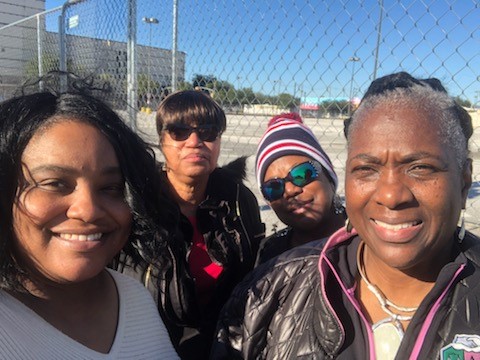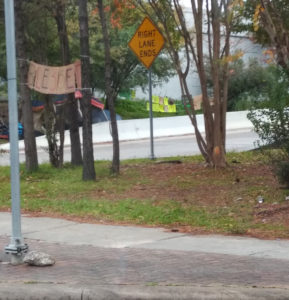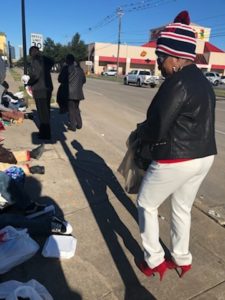
Greater Houston Nurses Taking it to the Streets
Homelessness is a global issue. It is on the rise and it impacts health physically and mentally. According to a recently published article in BMC Public Health, emergency departments are more often used by the homeless population for acute health care versus accessing preventative health care services. A 2018 study published in SAGE Open reported that the homeless population experiences health disparities with multiple chronic health conditions, mental illness, substance abuse, and depression.
The U.S. Department of Housing and Urban Development, Office of Community Planning and Development provides an Annual Homeless Assessment Report (AHAR) to Congress. On a single night in January 2018, there were
552,830 people who experienced homelessness in the United States. Most were sheltered (65%, 358,363) compared to 35% (194,467) who were in unsheltered locations. In the United States, 17 people per 10,000 experienced homelessness in 2018. Some of those who were in shelters (3,864 people) stayed in beds that were funded because the president declared natural disaster after four Hurricanes (Maria, Irma, Harvey, and Nate) and wildfires in the west. Twenty percent (111,592) of the homeless were children, 71% were over 24 years of age, and 9% ranged from ages 18-24. There were more men in unsheltered locations compared to women. Almost half (49%, 270,568) of the homeless people identified themselves as white compared to black/African Americans (40%, 219,807).In the state of Texas on a given night in 2018 there were 25,310 homeless people. There were 9 homeless people per 10,000 in the general population of the state. Individual estimates of homelessness in Texas was 19,199; 6,111 for people in families with children; 1,379 for unaccompanied homeless youth; 1,935 for veterans; and 3,269 for the chronically homeless individuals, according to the 2018 AHAR report.
Houston is the fourth largest city in the U.S. with over 2.3 million people, according to the U. S. Census Bureau. In January of 2019, there were 3,938 homeless individuals (unsheltered and sheltered) in the cities of Houston and Pasadena and Harris, Fort Bend and Montgomery Counties.
Risk Factors
There are various reasons that may cause an individual to experience homelessness. A 2009 study published in Psychiatric Services reported a significant association with childhood adversities and homelessness. The childhood adversities with significant findings include: having a history of running away, being ordered by a parent to leave the home, being neglected by a parent or caregiver, having a biological father incarcerated, being adopted, being in foster care, and the duration of welfare assistance before 18 years of age. Significant findings regarding socioeconomic situations included grade when respondent left school, economic difficulty in the past year, and currently employed. Mental health problems such as being diagnosed with depression and having a psychiatric hospitalization in the past five years were significant predictors of homelessness.
More recently, a 2019 study in the Community Mental Health Journal indicated the individuals with mental illness had high rates of homelessness. Addiction problems such as drugs in the past year was also a significant predictor of homelessness, according to the 2009 Psychiatric Services study. Oftentimes veterans return home after deployments to war zones suffering with invisible wounds such as post-traumatic stress disorder and traumatic brain injury. These individuals are at risk for experiencing homelessness, according to the National Alliance to End Homelessness (NAEH).
Homelessness can also be due to loss of property, family violence, or domestic violence. A 2018 study in the Journal of Community Psychology reported loss of support systems and social networks can also lead to a path of homelessness. Lower incomes often lead to an inability to pay for basics such as food, clothing, shelter, and transportation—and this places individuals at risk.
The Problem
It is a common sight in Houston to see homeless people living and sleeping on the streets. Whether you walk or drive around the city, you cannot help but see individual men and women panhandling in the streets, standing at corners and intersections. They will routinely walk up to your vehicle with signs, cups, and stretched out hands for money. The homeless can be seen sleeping on the sidewalks and huddled up against buildings and fences. Although shelters for the homeless exist and initiatives have been implemented in attempt to get the homeless off the streets of Houston, the homeless population is huge. Many people who are homeless still live in tent cities under freeways.
One might say, they want to be on the streets. One might say they do not want to follow the rules of the shelters. Therefore, they chose to be out on the streets. All of those sayings might be true. All the same, someone remains homeless.
One night during November 2018, I was driving home and it was very cold outside. The temperature was in the 30s or low 40s. I was overcome with sadness and sorrow to see so many people literally sleeping on the sidewalks without any shelter. I noticed that some did not have blankets. I found myself feeling so blessed and fortunate to not be living on the streets. But then, I wanted to do something. I said they need blankets and warm clothes if they will be sleeping on the streets in this cold weather.
Community Outreach Project
As a Christmas project for the Black Nurses Association of Greater Houston (BNAGH), we decided to give out blankets and socks to the homeless people in Houston. One Saturday afternoon (December 8, 2018), nurses from the BNAGH gathered the donated items to be distributed and walked the streets where a group of homeless men and women gathered. We drove to a local fast food place near Midtown, between downtown and The Texas Medical Center, and parked with permission from the manager. While still in the parking lot, a man asked me if we were getting ready to do something with the homeless. He was told we were going to pass out blankets, hats, socks, bottled water, and brown bags with snacks (peanut butter cracker, cuties, and peppermint candy canes). He stated his name and the name of his company and said he was there with his crew to do a film about the homeless in Houston. He asked if he could film us passing out the items and we told him yes. He said he would put us in the credits.
As we gathered all the items in large black plastic bags and started walking with the water, people started coming toward us to get the blankets and socks and other items. We gave away every item that we had. We even had a set of towels and a bar of soap to give out. One man said he wanted the soap. One man and lady were yelling for us to throw a blanket over the fence to them. One lady asked if we had anything girly. She asked for a pink hat. Everyone was so appreciative. Only one person did not want the items. He said he wanted dollars. He walked back into the street, running from car to car begging for money. Overall, it was an awesome experience. We provided items to approximately 60 homeless individuals.
Taking it to the streets takes courage and a compassionate heart. The needs of the homeless are many. One might feel overwhelmed if trying to take on every issue alone. It will take many people and resources. However, everyone can do something to help improve the health and lives of others. That is what the nurses of BNAGH wanted to do and that is why you might see homeless people in Houston with a sign displaying the words “BLESSED.”
Relevance to Nursing
Homeless Individuals are a vulnerable population and are sometimes considered invisible. However, they are not invisible. They can be seen and counted. They are at risk for health disparities including mental health issues. There were so many obvious needs. One was just basic hygiene. Nurses can advocate for housing because personal hygiene is important. Hand hygiene is the most effective way to prevent and control the spread of infection. Individuals experiencing homelessness face barriers to personal hygiene. For example, personal hygiene and self-care barriers are limited access to facilities for bathing, taking a shower, doing laundry, and washing hands. Such barriers to self-care and personal hygiene can cause one to be at risk for an infectious disease.
Some things that nurses can do to bring about change:
- Contact local coalitions for the homeless for information about their goals and objectives;
- Advocate for jobs and housing for the homeless;
- Contact and lobby local and state congressional and legislative officials regarding policies to help alleviate homelessness in America.
Such efforts will help reduce health disparities among this vulnerable population.
Stepping out of one’s comfort zone is not always easy to do. The first step seems to be the hardest. However, if nurses are to make a difference, then we must rise to the calling, step up to the plate, and do something positive to make a change. There are so many things that can be done. What I attempted to do was to provide warmth and comfort to a few people on the streets of my hometown. However, I have been inspired to do more. Hopefully you will be inspired to do something to help the homeless in your community feel encouraged and strive to be healthier.
Acknowledgements: The author wishes to thank Betty Davis Lewis, EdD, RN, FAAN and the Black Nurses Association of Greater Houston (BNAGH) and Prairie View A&M University College of Nursing faculty members for donations, and the three other nurses from BNAGH (Patricia Boone, RN, BSN; Vivian Dirden, RN, BSN, MS; and Dametria Robinson, BSN, RN-BC) who also walked in the streets of Houston to distribute the items to the homeless and provided photos. In addition, the author wishes to thank Carmen Lewis, MSN, RNC-MNN, IBCLC for providing the “BLESSED” photo.




